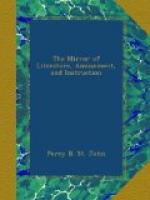TOWN-HALL, LIVERPOOL.
[Illustration: Town-Hall, Liverpool.]
From a small inconsiderable hamlet, Liverpool, within a century and a half, has been singularly advanced in national importance. In Leland’s time it had only a chapel, its parish church being at Walton, a distance of four miles from the town.
In the year 1571 the inhabitants of Liverpool sent a memorial to Queen Elizabeth, praying relief from a subsidy which they thought themselves unable to bear, wherein they styled themselves “her majesty’s poor decayed town of Liverpool.” Some time towards the close of this reign, Henry, Earl of Derby, in his way to the Isle of Man, staid at his house at Liverpool called the Tower; at which the corporation erected a handsome hall or seat for him in the church, where he honoured them several times with his presence.
Liverpool, from this time till the end of the next century, made but a slow progress either in the extent of its trade or in the number of its inhabitants; nor is there any remarkable occurrence recorded of it, except the siege of it by Prince Rupert, in the civil wars in 1644; some traces of which were discovered, when the foundation of the Liverpool Infirmary was sunk, particularly the marks of the trenches thrown up by the prince, and some cartouches, &c. left behind by the besiegers.
About the year 1698 an act of parliament was obtained, empowering the inhabitants to build a new church. From that time may be traced the rapid progress of population and commerce, until Liverpool has now become second only to the metropolis of Great Britain.
In 1760 the inhabitants of Liverpool were computed at 25,787; in 1811, at 94,376; and in 1821, at 118,972!
Far as the eye can trace the prospect
round
The splendid tracts of opulence are found;
Yet scarce a hundred annual rounds have
run.
Since first the fabric of this power begun;
His noble stream, inglorious, Mersey roll’d,
Nor felt his waves by lab’ring art
controll’d:
Along his side a few small cots were spread,
His finny brood their humble tenants fed;
At op’ning dawn with fraudful nets
supply’d
The padding skiff would brave his specious
tide,
Ply round the shores, nor tempt the dangerous
main,
But seek ere night the friendly port again.
The public buildings in Liverpool are not numerous, but they are worthy of attention. The Town-Hall, which is the subject of our present embellishment, is in a striking style of architecture. The first stone of this structure was laid in 1749, and the hall was opened in 1754. It is an elegant stone building, having two fronts; one towards Castle-street, the other towards the area formed by the New Exchange Buildings. Each front consists of an elegant range of Corinthian columns, supporting a pediment, and are themselves supported by a rustic base.




